Opinion Leader | Guan Tao
People often say that exchange rate rigidity and financial openness are dangerous policy combinations. In fact, even if the financial opening policy is not greatly adjusted, under the condition of increasingly open trade, it may also bring great challenges to capital flow management.
Since last June, the exchange rate of the RMB against the US dollar has risen in shock, with the largest cumulative increase of more than 12%. In particular, at the end of May and the beginning of June this year, the RMB exchange rate experienced a wave of rapid rise, hitting a new high in recent three years. The appreciation of RMB and the surplus of foreign exchange settlement and sales have become the important features of the current domestic foreign exchange market. However, judging from the operation of the foreign exchange market in August this year, although it cannot be said that this wave of RMB appreciation has ended, some new changes still need attention.
Domestic RMB exchange rate was stable and weak in August
The domestic RMB time point exchange rate and monthly average exchange rate both weakened. At the end of the month, the middle price and 4:30 p.m. closing price (the same below) fell 0.12% and 0.13% respectively from the end of the previous month. In that month, the monthly average middle price and closing price fell 0.05% and 0.04% month on month respectively (see Figure 1).
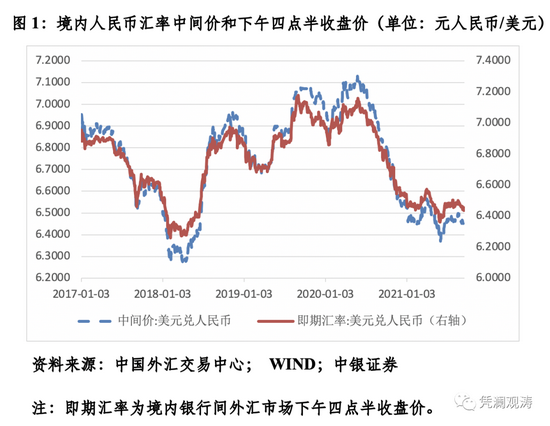

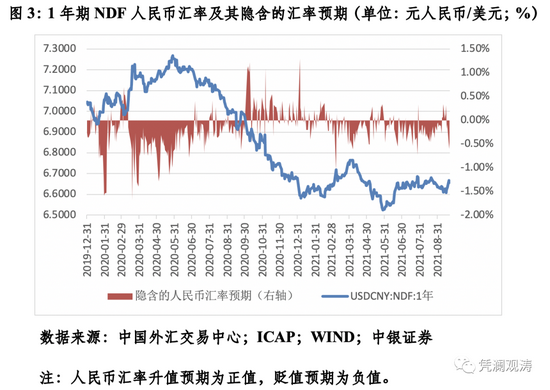
Of course, it is not yet possible to say that this wave of RMB appreciation has ended. May 2018 was an obvious turning point of the RMB exchange rate rebound from the beginning of 2017 to March 2018. Since then, for three or four consecutive months, the RMB time point exchange rate and monthly average exchange rate have declined by more than 1% month on month. In August this year, the decline of both the time point exchange rate and the monthly average exchange rate of RMB was relatively small. Moreover, in September (as of September 24, the same below), the median and closing prices of the monthly average exchange rate rose by 0.3% respectively compared with August, still belonging to two-way fluctuations (see Figure 1).
In addition, after the measures to increase the reserve requirement ratio for foreign exchange deposits of financial institutions by 2 percentage points in a lump sum in June, the monthly average one-year RMB/US dollar forward swap points were 1555, 1591, 1597 and 1726 basis points respectively from June to September. This shows that the substantial impact of the RRR measures on domestic foreign exchange liquidity is limited. Since the beginning of June, the rise and fall of the RMB exchange rate is mainly due to the strengthening of the dollar index in the international market. In September, the monthly average ICE dollar index was 92.76, up 2.7% from May (see Figure 4).
The weak RMB exchange rate in the current month was accompanied by a small shortage of domestic foreign exchange
two The "8.11" foreign exchange reform in 2015 established the current RMB exchange rate formation mechanism jointly determined by the domestic foreign exchange supply and demand relationship and changes in the international financial market. By the end of October last year, the transparency of the RMB exchange rate formation mechanism has improved after the counter cyclical factor was removed from the middle price quotation mechanism Step up.
From the perspective of monthly average exchange rate, from June of last year to February of this year, it has continued to rise unilaterally, and since March, there has been a two-way fluctuation of rising and falling. Among them, the closing prices of exchange rates in March, April, June, July and August all fell month on month, but the first four months mainly reflected the changes in the international financial market. Now in March, the closing price of the monthly average RMB exchange rate fell by 0.76% month on month, and the monthly average ICE US dollar index rose by 1.6% month on month. However, domestic foreign exchange supply still exceeded demand in the same period, and the bank's forward (including options) foreign exchange settlement and sales surplus totaled $15.5 billion; In July, the closing price of the monthly average RMB exchange rate and the US dollar index fell by 0.76% and rose by 1.6% month on month, respectively. The total surplus of foreign exchange settlement and sales by banks, namely forward (including options), was $8.1 billion (see Figures 4 and 5).
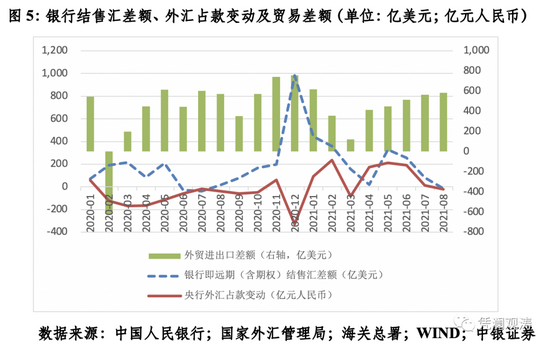
In August, the trend of RMB exchange rate was weak and the "gold content" was higher, reflecting the comprehensive influence of domestic and foreign market factors. In that month, the monthly average ICE dollar index rose 0.3% month on month; The total deficit of foreign exchange settlement and sales of forward (including options) by banks was 1.6 billion US dollars, which was the deficit again after one year; The central bank's foreign exchange account also ended its fourth consecutive rise, falling by 2 billion yuan month on month (see Figure 4 and Figure 5).
The reversal of domestic foreign exchange supply and demand is mainly due to the large decrease in net outstanding forward foreign exchange settlement. In the same month, the bank had a surplus of 13.6 billion dollars in spot foreign exchange settlement and sales, but this surplus was offset by a decrease of 15 billion dollars in the net outstanding forward foreign exchange settlement in the same period, and a decrease of 200 million dollars in the net outstanding foreign exchange settlement exposure of Delta for unmatured foreign exchange options. In total, the bank bought 15.2 billion dollars of foreign exchange in advance in the spot market, offsetting this surplus.
On the one hand, the net amount of unexpired forward foreign exchange settlement decreased significantly, because a large number of forward foreign exchange settlement in response to exchange rate appreciation in the earlier period had expired and performed. In that month, the performance of forward foreign exchange settlement was US $37.4 billion, accounting for 18.6%, up 0.9 percentage points month on month; The performance of forward foreign exchange purchase reached US $25.3 billion, accounting for 13.8%, down 2.6 percentage points month on month; The performance surplus of forward foreign exchange settlement and sales was US $12.1 billion, an increase of US $7.4 billion month on month (see Chart 6).
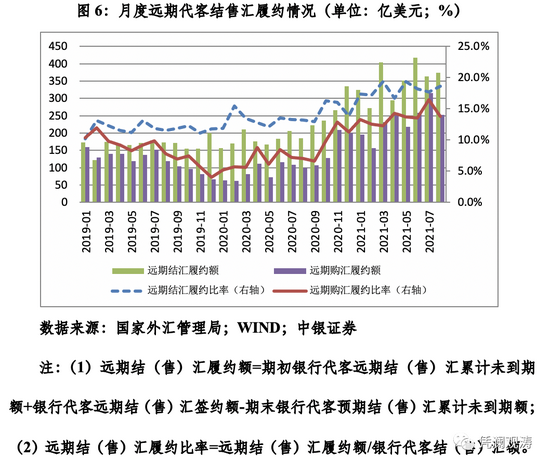
On the other hand, because the current enterprises have increased the hedging of exchange rate depreciation risk. In that month, the contracted amount of forward foreign exchange settlement and foreign exchange purchase was US $31.8 billion and US $34.7 billion respectively, and the deficit of the contracted amount of forward net foreign exchange settlement was US $2.9 billion, the first time in three years. The hedging ratio of forward settlement (sale) of foreign exchange measured by the proportion of forward settlement (sale) of foreign exchange contracts in the export (import) amount shows that in August, the hedging ratio of forward settlement (sale) of foreign exchange was 12.5%, down 1.7 percentage points month on month, the second consecutive month of decline, which reflects that the convergence of exchange rate volatility has curbed the exchange rate hedging motivation of market entities. Among them, the hedging ratio of forward foreign exchange settlement was 10.8%, down 2.4 percentage points month on month; The hedging ratio of forward foreign exchange purchase was 14.7%, down 0.9 percentage points month on month (see Figure 7). It can be seen that in the case of market depreciation expectations, the extent of weakening of forward foreign exchange purchase motivation is smaller than that of forward foreign exchange settlement.
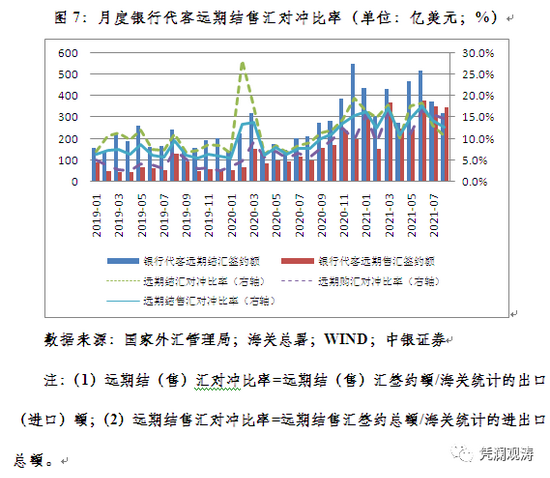
Exchange market shocks highlight the importance of flexible exchange rate
The large trade surplus reflects the strength of China's foreign economic sector and provides an important support for the stability of the RMB exchange rate. Since the second quarter of last year, due to the good prevention and control of the epidemic, China has taken the lead in resuming production of the whole industrial chain supply chain, with rapid growth in exports and expanded trade surplus. This year, China continues to enjoy this dividend. In the first eight months, exports increased by 34% year on year (in US dollars), and the trade surplus was $362.5 billion, up 29% year on year.
However, with the formation of exchange rate becoming more and more market-oriented, the RMB exchange rate has more and more characteristics of a mature currency. That is to say, the trend of RMB market exchange rate is increasingly characterized by asset price, showing a random walk, leading to a non simple linear relationship between trade surplus and exchange rate appreciation and depreciation.
At the end of 2006, the Central Economic Work Conference proposed that promoting the balance of international payments should be an important task to maintain macroeconomic stability, that is, not to pursue trade surplus, and the more foreign exchange reserves, the better. By the end of June 2014, China's foreign exchange reserves had reached nearly $4 trillion, an increase of $2.93 trillion over the end of 2006. Over the same period, the trade surplus of goods under the customs criteria totaled US $1.69 trillion, equivalent to 58% of the increase in foreign exchange reserves.
In 2015, the "8.11" foreign exchange reform and the unexpected devaluation of RMB triggered the centralized adjustment of the market for "hiding foreign exchange for the people" and "debt repayment". As a result, although the annual trade surplus in 2015 and 2016 was more than 500 billion US dollars, far exceeding the annual average surplus of more than 200 billion US dollars from 2007 to 2013, it was not equal to the scale of capital outflow, leading to the continuous reduction of foreign exchange reserves. By the end of 2016, the RMB exchange rate had fallen to around 7, and the foreign exchange reserve had fallen to around 3 trillion. The market strongly argued whether to maintain the exchange rate or reserve.
In the process of this round of RMB appreciation, the correlation between the trade surplus and the surplus of foreign exchange settlement and sales of banks is also relatively low. From January last year to August this year, the correlation between the customs import and export balance and the bank forward (including options) balance of foreign exchange settlement and sales was extremely weak positive correlation 0.149, and from February to August this year, it turned to extremely weak negative correlation 0.265. In August of this year, the customs import and export surplus was 58.3 billion US dollars, an increase of 1.9 billion US dollars month on month, but the deficit of foreign exchange settlement and sales of forward (including options) by banks was 9.7 billion US dollars month on month (see Figure 5).
It is often said that exchange rate rigidity and financial openness are threatening policy combinations. In fact, even if the financial opening policy is not greatly adjusted, under the condition of increasingly open trade, it may also bring great challenges to capital flow management. The traditional challenge is to advance or postpone the collection and payment of foreign exchange for import and export, as well as the internal transfer pricing behavior of multinational companies, which may break through the barriers of capital control. The new challenge is to guide enterprises to adhere to risk neutral awareness and increase exchange rate risk hedging, which may also lead to large capital inflows and outflows.
As mentioned earlier, in August this year, the domestic foreign exchange supply and demand relationship reversed slightly, because the market increased the impact of exchange rate depreciation risk. In the current period, the surplus of spot foreign exchange settlement and sales of banks increased by $3.9 billion month on month, including the surplus of foreign exchange settlement and sales of agency trade of $23 billion, an increase of $7.6 billion month on month, contributing nearly twice to the increase in the surplus of spot foreign exchange settlement and sales of banks. However, during the same period, the net unmatured forward foreign exchange settlement and the net foreign exchange settlement exposure of foreign exchange options Delta declined, resulting in the bank's net purchase of foreign exchange of 13.6 billion dollars in advance in the spot market, offsetting the increase in the surplus of spot foreign exchange settlement and sales.
According to the theory of exchange rate overshoot, asset price adjustment is usually faster than the real economy, leading to the market exchange rate prone to excessive rise and depreciation of the equilibrium exchange rate determined by relative economic fundamentals. Extremely, such as the high intensity cross-border capital flow shock at the beginning of the "8.11" foreign exchange reform, it took ten years to accumulate a trade surplus of two trillion yuan, but in two years, the capital outflow was on the scale of one trillion yuan. This term mismatch caused a serious imbalance between the supply and demand of domestic and foreign exchange in the market in the short term, which led to the abnormal situation of large trade surplus accompanied by strong depreciation expectations. The recent volatility of the foreign exchange market is different from that of six years ago, but it also rings an alarm bell again, reminding us that the market is not linear but nonlinear.
When the supply and demand of foreign exchange is unbalanced, either price settlement (exchange rate floating) or quantity settlement (foreign exchange reserve intervention or capital exchange control) is the policy choice (i.e. the "impossible triangle" of foreign exchange policy). If we choose to improve the marketization of exchange rate and increase the flexibility of exchange rate, it will help reduce the dependence on quantitative tools, especially administrative control means. Since 2018, the RMB exchange rate has shifted from unilateral decline to two-way fluctuation, especially since the RMB exchange rate broke 7 in August 2019, we have initially enjoyed the benefits in this regard. Next, we should continue to deepen the reform of exchange rate marketization to better meet the needs of open economic development, and continue to promote trade and investment liberalization and facilitation.
This article was originally published in First Finance
(About the author of this article: Global Chief Economist of BOC Securities)








